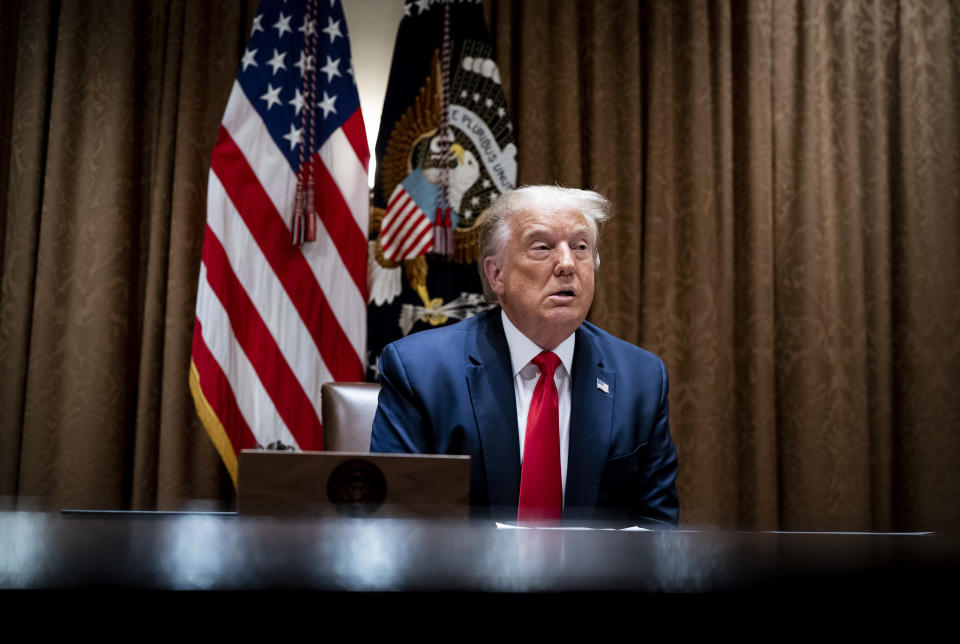Coronavirus stimulus: President Trump's action on unemployment benefits is falling short, experts say
President Donald Trump’s memorandum extending the extra unemployment benefits is falling short of what an act of Congress could have provided.
The memorandum that Trump signed after Congress failed to reach a new stimulus deal has numerous weaknesses, according to Andrew Stettner, an unemployment insurance expert and senior fellow at the Century Foundation, a think tank.
It provides limited funding; the benefits are hard to administer; there’s no national policy; and the total amount of benefits is smaller than promised, Stettner said.
“All these are symptoms of why it was really important to come to a real agreement with Congress to continue this program,” he said.

‘It just pales in comparison’
Trump offered an additional $400 a week as a way to help unemployed Americans, but the actual supplement most will get is just $300 — if their states implement the extra benefits at all.
“I’m taking action to provide an additional or an extra $400 per week in expanded benefits,” Trump said at his golf club in Bedminster, New Jersey, on Aug. 8 when he signed the memorandum. “That’s generous, but we want to take care of our people.”
Read more: Here’s what you need to know about unemployment benefits eligibility
By contrast, the Democrats’ proposal called the HEROES Act would have extended the extra $600 a week provided under the CARES Act, delivering $130 billion in aid to families by the end of September, according to an analysis by Stettner and Michele Evermore, a senior policy analyst at the National Employment Law Project. That is $86 billion more than the maximum amount that could be distributed under Trump’s memorandum.
“It just pales in comparison to what we've been delivering universally for the CARES Act and then the HEROES Act,” Stettner said.
‘It's the exact same pot of money’

The up to $44 billion earmarked to fund Trump’s unemployment benefits could also be used for other purposes. The funds come from the Federal Emergency Management Agency (FEMA) and are also used to fund disaster relief, meaning they could run out sooner than expected if a natural disaster occurs.
That’s already happened. Iowa’s Gov. Kim Reynolds this weekend requested $4 billion for those affected by the recent derecho storm in her state. The request was approved by the president.
“They're applying for FEMA aid and it's the exact same pot of money that's being used for employment insurance benefits,” Evermore told Yahoo Money earlier this week. “I imagine this will happen more than once in the next month.”
‘For the local economies, it means less jobs’
The $86 billion shortfall — the difference between fully funding the $600 and the total benefits provided under Trump’s memorandum — between August and September will also hurt local economies. The states that will see the greatest losses in potential unemployment aid are California ($14.8 billion), New York ($9.4 billion), Pennsylvania ($5.6 billion), and Texas ($4.9 billion), the analysis found.
“For the local economies, it means less jobs,” Stettner said. “Most of our [local] economies are consumer economies...the sectors that lost the most jobs were retail, trade, leisure, hospitality, and services. These are dependent on people having money to spend.”

Generous government support has kept Americans’ income at high levels during the pandemic. Even as the nation’s gross domestic product shrank by 32.9% in the second quarter, personal income grew by 7.3%, according to the Bureau of Economic Analysis (BEA). But the benefits provided under the memorandum may not be sufficient enough to have a similar impact.
“Now, people are going to have these problems that are familiar with unemployment: people losing their homes, people having to move in with their families, not being able to have their kids go back to college. We’re going to start seeing more of those problems,” Stettner said. “The money they’re giving is just a band-aid, and it could facilitate not taking care of the problems.”
‘Different views of the unemployed in different parts of the country’
Another issue with the $300 benefits is that they won’t be equally distributed in different states, compared with the CARES Act, where each state added a flat $600 in weekly benefits.
The federal government contributes $300, while states have two options for paying out the rest of the benefit. States can count $100 in unemployment benefits they are already paying as the match required by Trump’s memorandum. By doing that, jobless workers only get $300 extra a week. Or, states can find funds to provide an additional $100 on top of the $300 from the federal government.
Most states are going for the $300 as a cheaper and less complex option to administer the benefits. So far, Kentucky is the only state that has committed to paying the extra $100.
But some states may either not apply for benefits or decline to use them — as South Dakota did. That means many jobless Americans may see no extra benefits, depending on their state
“People have different views of the unemployed in different parts of the country,” Stettner said. “You don't have a guarantee of this aid, depending on where you live.”
Denitsa is a writer for Yahoo Finance and Cashay, a new personal finance website. Follow her on Twitter @denitsa_tsekova.
Read more:
Analysis: 1 in 3 jobless Americans could be left out of Trump's action on unemployment
Even as GDP tanked, personal income grew thanks to government support
Read more personal finance information, news, and tips on Cashay
Follow Yahoo Finance on Twitter, Facebook, Instagram, Flipboard, SmartNews, LinkedIn, YouTube, and Reddit.

 money
money 

